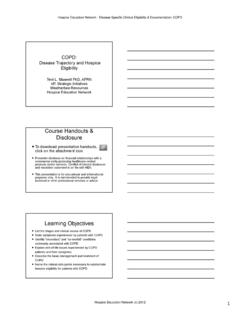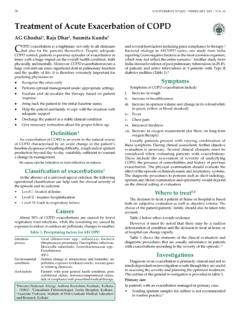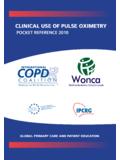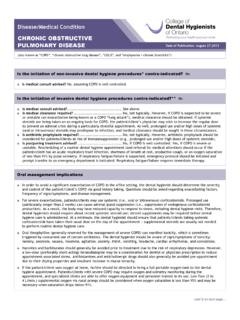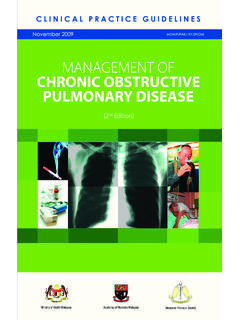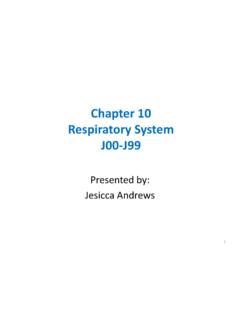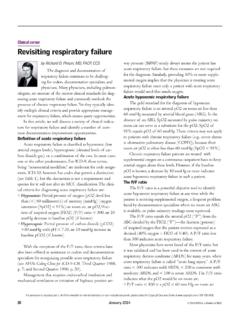Transcription of 106 Anaesthesia and COPD - FRCA
1 Anaesthesia in patients with Chronic Obstructive Pulmonary Disease Authors: Dr Mai Wakatsuki and Dr Tom Havelock Self-assessment Please answer questions 1-3 true or false. 1. The following are true of chronic obstructive pulmonary disease ( copd ): a. It is a condition that is solely caused by cigarette smoking b. Cessation of smoking improves post operative outcome c. Presence of wheeze in a clinical examination is a useful marker of disease severity d. Completely reversible airways disease is the hallmark of copd e.
2 copd and asthma are mutually exclusive conditions. 2. The following are true regarding copd : a. Patients with cor pulmonale should be given aggressive diuresis preoperatively to reduce peripheral oedema b. High flow FiO2 should be used with caution in copd c. Morphine is contraindicated in copd as it causes respiratory depression and bronchospasm d. Epidural Anaesthesia is contraindicated in copd as it may paralyse the intercostal muscles required for breathing e. Interscalene nerve block may adversely affect patients with copd 3.
3 The following may benefit patients with copd undergoing surgery: a. Nebulised beta blocker b. Oral steroids for stable copd c. Antibiotics for respiratory infection d. Respiratory physiotherapy e. A preoperative exercise regime 4. What signs and symptoms do patients with copd have? 5. How do you treat patients who have an acute exacerbation of copd ? 6. What preoperative investigations would you consider for a patient with an FEV1/ FVC ratio of 60% and an FEV1 that is 50% of the predicted value? 7. A 60 year old patient is listed for below knee amputation for peripheral vascular disease.
4 He has moderate copd , discuss which anaesthetic technique you would choose and why. 8. What are the problems of general Anaesthesia in patients with copd ? Introduction . Chronic obstructive pulmonary disease ( copd ) is a very common respiratory disorder that affects many people across the world. The long term survival of patients with severe copd undergoing any type of surgery is poor (47% 2 year mortality) and they are at significant risk of postoperative morbidity, especially pulmonary complications.
5 However with risk identification, pre-operative optimisation and appropriate anaesthetic management, the risks of developing postoperative pulmonary complications can be reduced even in patients with severe disease. Pathophysiology of copd copd is a generally progressive inflammatory disease of the lungs that is characterised by airflow limitation that is not fully reversible, and is often complicated by significant systemic manifestations and co-morbidities.
6 The inflammation is usually secondary to inhaled noxious particles or gases, the most common of which worldwide is cigarette smoke. The lung pathology in copd is a combination of inflammatory small airways disease (obstructive bronchiolitis) and parenchymal destruction (emphysema). The relative contribution of these two processes and thus the resultant physiological abnormalities varies from person to person. The small airways disease leads to obstruction and air trapping.
7 This occurs chronically, but importantly also occurs dynamically under stress. The resulting dynamic hyperinflation adversely affects ventilation / perfusion (VQ) mismatching, the loading and mechanics of the respiratory muscles, and the sensation of dyspnoea. The loss of lung parenchyma decreases gas transfer, reduces the pulmonary capillary bed and worsens VQ mismatching. Reducing the parenchymal support of the walls of the small airways contributes to the airflow limitation.
8 The end result of the VQ mismatching, decreased gas transfer and alveolar hypoventilation is hypoxaemia and sometimes hypercarbia. The hyperinflation causes marked dyspnoea even without a fall in PO2. Importantly copd patients can have significant extra pulmonary disease. This can be a direct result of copd such as cor pulmonale, respiratory and skeletal muscle wasting and weight loss, or co-morbid diseases, especially cardiovascular, which are more prevalent in this population.
9 Clinical Features of copd The typical features of copd are dyspnoea, wheeze and cough with or without sputum production. The onset of copd is insidious and most patients are symptomatic either with cough or progressive dyspnoea long before they present to medical services. Therefore a diagnosis of copd should be considered in all patients over forty years old with a significant smoking history (>10 pack years) who should be questioned about symptoms. In the early stages of copd the dyspnoea is usually associated with exertion.
10 The breathlessness is characteristically differentiated from asthma by the lack of nocturnal symptoms (in early copd ), a lack of significant diurnal variability, a lack of association with allergy and its persistent and progressive nature. Be aware that asthma and copd can co-exist in the same patient. Patients with significant hyperinflation can often develop significant dyspnoea even with relatively normal spirometry. The dyspnoea is often accompanied by significant anxiety. In exacerbation breath stacking and dynamic hyperinflation results which, unless it is rapidly treated, can quickly lead to respiratory failure.










